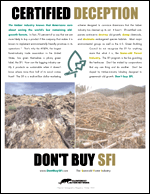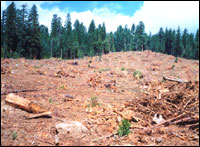If you’ve got plans to undertake a woodworking project — building a deck, say, or a fancy new china cabinet — you’re probably not going to figure a plane ticket to Burma or Humboldt County, Calif., into the budget, even if you’d like to be sure that the wood you’ll use has been harvested sustainably. Hence, the rise of green labeling: a convenient way for consumers to put their money where their values are.

But can you trust a label just because it says “sustainable” and sports a fetching graphic of a tree? Where the timber industry’s “Sustainable Forestry Initiative” is concerned, many environmental activists say, it’s caveat emptor.
The Sustainable Forestry Initiative was developed in 1994 by the American Forest & Paper Association, the largest timber lobby in the world, as an industry program to boost environmental performance. While some environmentalists say the organization offers a framework to help industry improve, Michael Brune, executive director of the Rainforest Action Network, calls the SFI “a new green coat of paint over the same tired practices.” In November 2003, RAN and a coalition of environmental partners began a campaign called “Don’t Buy SFI” to enhance public awareness about what they call industry-sponsored greenwashing.

If SFI has existed as an organization for 10 years, why are environmentalists particularly concerned right now? Because last year the group launched a new “green” product label — and backed it with a massive, multi-million dollar marketing campaign featuring full-page advertisements in The Wall Street Journal and spots on National Public Radio, among other outlets. This push, says RAN Old-Growth Campaign Director Jennifer Krill, constitutes “strategic deception. Everything about the SFI, at its core, is misleading.”
Charging that the program doesn’t protect forests and ignores crucial social issues, the anti-SFI coalition, which includes such groups as ForestEthics, Greenpeace, Sierra Club, American Lands Alliance, and the Natural Resources Defense Council, has produced a website with a photo gallery of lands devastated by logging. Sobering shots of clearcuts are nothing new — but the sites in these images were harvested by SFI-certified companies that qualify for the new eco-label.
“[Promoting this label] is a reflection of the logging industry in deep denial,” says Brune. “They’re hearing a consistent message from their customers, their shareholders, and the public at large that the status quo is unacceptable — yet they’re proceeding on course as if nothing has changed.”
SFI: Same Forestry Industry?

SFI: Same Forestry Industry?
The anti-SFI coalition considers the program’s certification system inferior to one operated by the Forest Stewardship Council. FSC, an independent initiative founded by forestry professionals, environmentalists, indigenous groups, and sociologists in 1993, is “miles ahead” of its industry-backed competitor, according to Brune.
Certainly, the standards differ in several critical ways:
- Old growth and endangered forests. SFI has “no standards preventing old growth from being logged, period,” says Daniel Hall, forest biodiversity program director at American Lands Alliance. Since old-growth protection isn’t one of SFI’s “core indicators” for compliance, protecting ancient trees is voluntary, not mandatory. By contrast, FSC’s standards specifically require protecting the full conservation value of ancient forests, meaning no diminishment in their ecological function is allowed.
- Biodiversity. Unless carefully managed, diverse natural forests in places like the southeastern U.S., which has more endangered forest ecosystems than anywhere else in the country, can quickly turn into monocultural tree farms. SFI standards don’t take this into account, permitting member companies to log a diverse forest and replace it with a single species. Environmentalists say that this emphasis on logging and replanting ignores critical factors like wildlife habitat and biodiversity. “The ‘cut a tree, plant a tree’ model does nothing for ecosystems,” says Kim Marks, a field organizer with ForestEthics’ wood campaign. FSC’s core criteria for forest management include preservation of ecosystem diversity.
- Global forests. Seventy percent of the world’s remaining pristine forest tracts are in Russia, Canada, and Brazil. SFI only certifies U.S. and Canadian mills, not actual logging operations, so the companies that operate those mills may well buy wood from sensitive overseas locations and still qualify for the label. FSC tracks wood from the forest to the shelf and applies its standards in at least 57 countries around the world.
- Social issues. FSC flatly refuses to certify wood harvested from areas where there are unsettled land claims or outstanding disputes involving indigenous people. By contrast, nothing within SFI’s standards requires consultation with native people about logging practices. Similarly, FSC recognizes workers’ rights to union organization, while SFI does not.
Moreover, says Hall of American Lands, any system is only as credible as its lowest common denominator — and “if you look at the companies that follow the minimum standards SFI allows, you’re talking about some of the worst forest and paper product companies on the continent.”

A Sierra Pacific Industries clearcut in
California.
Photo: Central Sierra Environmental
Resources Center.
Sierra Pacific Industries — which is certified by SFI but not by FSC — clearly demonstrates the difference between the two labeling models, Hall contends. The company benefits from SFI’s lack of forest-diversity standards, Hall says, “because Sierra Pacific is converting 70 percent of their 1.4 million acres of California forests to these ecologically impoverished pine plantations.” The firm has also come under major criticism in the past for its clearcutting practices.
Consumers buying green-labeled products generally assume that the product has been tracked from the chainsaw to the shelf — a process called “chain of custody” tracking. But companies can qualify for the SFI label without knowing where the vast majority of their wood products originate, Brune says, which undermines the credibility of the label.
The SFI label’s certification process applies only to particular mills, not to specific companies or products. Thus if you go to your local lumberyard looking for a two-by-four, you might see one with SFI’s “certified participant” label — but that label doesn’t necessarily mean that the board came from a certified logging operation. It means that the mill where the board was produced meets SFI’s loose and often voluntary standards.
In fact, it’s technically possible that none of the wood bearing the SFI label is harvested in a way compatible with SFI standards. To earn the label, mills that are primary wood producers are required to obtain one-third of their wood from suppliers that are either enrolled in the SFI program or meet guidelines set by the American Tree Farm System, which “make SFI standards look rigorous,” says Hall. Two-thirds of the wood doesn’t have to meet any standards at all.
“If you don’t know where the wood is coming from, how do you know that it was logged responsibly?” says Brune. “It’s a farce.”
A Clearcut Case?
SFI critics acknowledge that the organization has made some strides. It has moved toward independence from the timber industry by creating a separate “Sustainable Forestry Board” to provide standards input and has improved third-party verification of company practices. And, the new board says, social concerns such as labor rights and indigenous people’s rights will be considered when SFI revises its standards in 2005.

Building momentum.
Laurie Wayburn, president of the nonprofit Pacific Forest Trust, an organization focused on preserving and enhancing private forestland, is one of five conservation-organization representatives on the 15-member Sustainable Forestry Board. She has also worked with FSC from the group’s beginning. “[W]e need many different answers to stop [the deforestation] trend, and joining the [SFI board] is an opportunity to work with some of the key owners of forestland in the country,” she says.
Paul Portney, another member of the Sustainable Forestry Board and president of the natural-resources think tank Resources for the Future, concurs. “The board has been able to move the industry along at a much more rapid clip on issues related to sustainability than likely would have been the case if SFI had not been launched and [the Sustainable Forestry Board] had not been created,” he says. Despite their opposition to the labeling program, some environmental critics of SFI agree on that score.
Bill Banzhaf, president of the board, says that FSC and SFI “have different strengths” as labeling programs. “FSC is very strong on chain of custody,” Banzhaf allows. But, he contends, “they can’t cover the breadth of forest that SFI can.”
Of course not, counters Hall: “There’s a reason why SFI has such broad participation in their system: They took a look at what people were already doing, and said, ‘That’s what we’re going to certify.'”
Likewise, RAN’s Krill blasts the program’s entire standards document as “meaningless,” noting that most of its “core indicators” merely require compliance with existing U.S. federal law. “After looking at the document, I came to the conclusion that this is the most sophisticated … greenwashing program in America’s history,” she says. “There is nothing in this program that ensures forest protection … There’s nothing in this label or in this program that a consumer can trust.”
Marks of ForestEthics agrees. Asked if SFI has a role to play in an ecologically sound future, she responds thusly: “You can’t stop corporations from getting together and plotting and scheming, and that’s what SFI is. That’s the role they play. It interferes with our efforts. It just gets in the way.”
While prominent retailers aren’t yet leaping to embrace the SFI label, environmentalists fear that the current marketing offensive combined with intensive industry lobbying will build support among institutional customers. Corporations, says Brune, should pay heed to an age-old maxim: The customer is always right — “and customers overwhelmingly want old growth protected,” he says.


